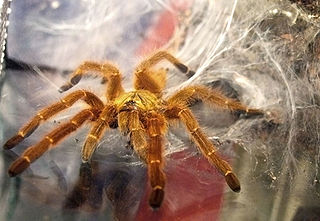
The Harpactirinae are a subfamily of tarantulas which are native to the continent of Africa. Like many Old World tarantulas, they have a relatively strong venom, and can inflict a painful bite.
Scinax constrictus is a species of frog in the family Hylidae.
The knotty pebblesnail, scientific name Somatogyrus constrictus, of minute freshwater snails with an operculum, aquatic gastropod molluscs or micromolluscs in the family Hydrobiidae. The taxonomic validity of this species has been questioned; it may represent morphological aberrations of other, valid species. If it is a valid species, it would be assessed as threatened.

Trissexodon constrictus is a species of air-breathing land snail, a terrestrial pulmonate gastropod mollusk in the family Trissexodontidae.
Afrocimex constrictus, also called the African bat bug, is an insect parasite of Egyptian fruit bats in bat caves in East Africa. Population sizes can comprise millions of individuals and in a cave there can be one to 15 bugs per bat. It was estimated that adult African bat bugs feed approximately once per week thus withdrawing 1-28 microlitre blood per day per bat.
Rimapenaeus constrictus, common name roughneck shrimp, is a species of prawn found along the coast of the Atlantic Ocean. It has been recorded in coastal regions of Bermuda, Brazil, Canada and the United States.
Latirus constrictus is a species of sea snail, a marine gastropod mollusk in the family Fasciolariidae, the spindle snails, the tulip snails and their allies.
Eucratoscelus constrictus is a species of tarantula belonging to the family Theraphosidae. They produce a venom that contains a group of neurotoxic peptides.
Cloniocerini is a tribe of longhorn beetles of the Lamiinae subfamily. It was described by Lacordaire in 1872. It contains the single genus Cloniocerus, and the following species:

Yantaromyrmex is an extinct genus of ants first described in 2013. Members of this genus are in the subfamily Dolichoderinae of the family Formicidae, known from Middle Eocene to Early Oligocene fossils found in Europe. The genus currently contains five described species, Y. constrictus, Y. geinitzi, Y. intermedius, Y. mayrianum and Y. samlandicus. The first specimens were collected in 1868 and studied by Austrian entomologist Gustav Mayr, who originally placed the fossils in other ant genera until the fossils were reviewed and subsequently placed into their own genus. These ants are small, measuring from 4 to 6 mm in length and can be characterized by their trapezoidal shaped head-capsules and oval compound eyes that are located slightly to the rear of the capsules midpoint, with no known ocelli present.
Cloniocerus albosticticus is a species of beetle in the family Cerambycidae. It was described by Breuning in 1940.
Cloniocerus bohemanni is a species of beetle in the family Cerambycidae. It was described by White in 1855.
Cloniocerus hystrix is a species of beetle in the family Cerambycidae. It was described by Johan Christian Fabricius in 1781.
Cloniocerus kraussii is a species of beetle in the family Cerambycidae. It was described by White in 1855. It is known from Mozambique, Angola, Madagascar, Zambia, and South Africa.
Cloniocerus lamellicornis is a species of beetle in the family Cerambycidae. It was described by Breuning in 1950. It is known from Kenya.
Cloniocerus ochripennis is a species of beetle in the family Cerambycidae. It was described by Breuning in 1940. It is known from Tanzania.
Bradyrhynchoides constrictus is a species of broad-nosed weevil in the beetle family Curculionidae. It is found in North America.
Tomoderus constrictus is a species of antlike flower beetle in the family Anthicidae. It is found in North America.

Perigenes constrictus is a species of dirt-colored seed bug in the family Rhyparochromidae. It is found in Central America and North America.
Cyclotrachelus constrictus is a species of woodland ground beetle in the family Carabidae. It is found in North America.




